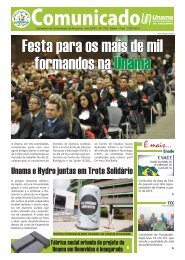C:\ARQUIVO DE TRABALHO 2011\EDI - Unama
C:\ARQUIVO DE TRABALHO 2011\EDI - Unama
C:\ARQUIVO DE TRABALHO 2011\EDI - Unama
You also want an ePaper? Increase the reach of your titles
YUMPU automatically turns print PDFs into web optimized ePapers that Google loves.
56<br />
ABSTRACT<br />
EVALUATION OF HYDRAULIC AND ORGANIC LOAD FROM<br />
THE AIRPORT OF ETE LARGE<br />
This work aims the evaluation of the hydraulic and organic treatment of sewage (TEE) in<br />
the International Airport of Belém (IBA), which had its experimental design in two steps:<br />
first and second. The first step, it comprised to characterize the raw drainage of ETE in<br />
therms of flow, pH, COD, TSS, N-amonical, P and E-coli, during the dry and rainy periods<br />
in the Amazonian Region (2007 to 2008) with the objective of obtain information about<br />
the hydraulic load percapta (L / inhabitants.day) and load percapta of pollutants (g /<br />
inhabitants.day). And in the second phase, evaluation was conducted in two separate<br />
treatment systems (activated sludges and UASB-activated sludges), so to estimate the<br />
informations about the production of sludge (L / inhabitants.day), energy consumption<br />
(kw), demand for area (m 2 / inhabitants), efficiency of COD (E COD<br />
) and effluent COD (COD efl<br />
)<br />
In the first stage, the average results were: dry period ¾18,87±9,39 L / inhabitants.day;<br />
8.38 ± 5.95 gCOD / inhabitants.day; 2.92 ± 2.03 gSST / inhabitants.day; 1.85 ± 0.98 gNamoniacal<br />
/ inhabitants.day, and 0,12±0,06 gP / inhabitants.day, and rainy season<br />
23,67±7,41L / inhabitants.day; 10 ± 4.97 gCOD / inhabitants.day; 3.66 ± 1.70 gSST /<br />
inhabitants.day; 1.72 ± 1 gN-amoniacal/ inhabitants.day, and 0.14 ± 0.06 gp /<br />
inhabitants.day. These results, by applying the hypothesis test of Kruskal-Wallis, showed<br />
no statistical differences between the rainy season and dry season (p>a=5%) in hydraulic<br />
and organic terms, allowing the inference that the wastewater generated TEE in the IBA<br />
has characteristics independent of the flow of passengers + employees. In the second<br />
stage of this work, it obtained for the activated sludge’s system: Pequivalente: 1236<br />
inhabitants, sludge’s production of 1.97 L / inhabitants.day, consumption of energy for<br />
aeration of 0,744 kw, demand for 0,038 area of m 2 / inhabitants and E COD<br />
= 80% and COD efl<br />
.= 90 mg / L. and for UASB-activated sludges obtained P EQV<br />
: 1236 inhabitants, production<br />
of sludge of 1.97 L / inhabitants.day, consumption of energy for aeration of 0744 kw, 0038<br />
demand for area of m 2 / inhabitants and E COD<br />
= 80% and COD efl<br />
.= 90 mg / L. Evaluating the<br />
question generated sludge’s production, energy and specific area demand, it is clear that<br />
the adoption of the system UASB + LA is which represents the best alternative for the<br />
treatment of sewage from TEE of AIB, as that treats the same amount of sewage and the<br />
removal efficiency of COD equivalent to the system of LA smaller amount of sludge<br />
generated and energy consumption.<br />
Key words: Airport, treatment of sewage, hydraulic load , pollutants load<br />
1 INTRODUÇÃO<br />
Especificamente na área de saneamento o registro da vazão assume papel de<br />
destaque para a solução de problemas relacionados ao abastecimento de água, drenagem<br />
urbana, análise da capacidade de recebimento de esgotos em corpos d’água, siste-<br />
Traços, Belém, v. 12, n. 25, p. 55-69, jun. 2010
















